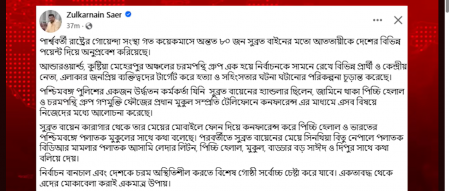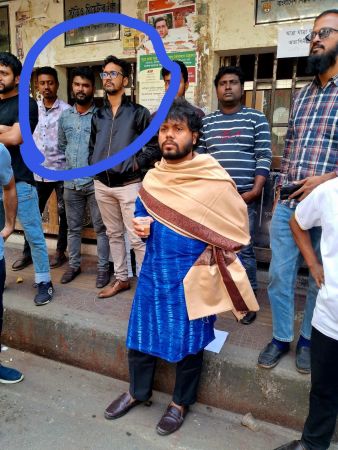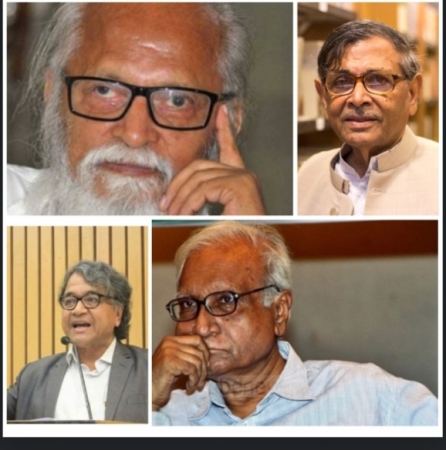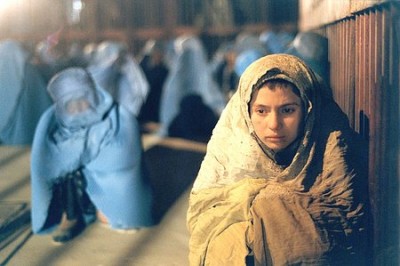ডিভিডি কিনে গতকাল রাত্রে মুভিটা দেখলাম।
Osama," the first film made in post-Taliban Afghanistan, is a gripping small story with big implications about what happens when a desperate family commits the unthinkable crime — sending a daughter out in boy's clothing to earn a living.
ছবিটা সকলেরই দেখা উচিত। তালেবান শাসন পরবর্তী আফগানিস্তানে প্রথম চলচ্চিত্র এটি। গোল্ডেন গ্লোব সহ বহু চলচ্চিত্র উৎসবে পুরস্কৃত।
রিভিউ তুলে দিলাম নেট থেকে।
In the cinema of witness, a movie's merit lies largely in its fidelity to the reality of oppression. Yet the film has to have more — else it would only be journalism. In the first film made in post-Taliban Afghanistan, writer/director/editor Siddiq Barmak succeeds, skillfully and without a false note, in making an engrossing drama of life under the Taliban. It is an Ockham's razor of narrative and image which reaches out from the screen and cuts the viewer; more than the heart bleeds as the twelve-year old protagonist (Marina Golbahari) negotiates her impossible world.
The film takes place sometime after the rise of the Taliban, and opens with a scene of a demonstration. Women clad in blue burqas cascade down a dusty hill, demanding the right to work to feed their families. These are women without men, who were taken over years of war and chaos. Notwithstanding the chanted qualification to the women's demands, "We are not political!" the Taliban know what Western feminists teach: the personal is the political. Through weapon and water cannon, the Taliban break up the demonstration.
Barmak conveys the violence obliquely. The agents of the Taliban are left out of frame, and the carnage is mostly symbolic. A ruined burqa washes down the street as the demonstrators scream and flee pell-mell. Barmak's indirect approach evokes the nature of Taliban repression. It is not excessive; no massacre is needed. Just enough to sow fear and terror. Throughout the film, Taliban agents are omnipresent to police even the slightest departure from prescribed gender conduct, even in private spaces. Their malevolence, even without violence, is strongly felt.
The young protagonist, not named, gets caught up in the demonstration, and she is terrified. To her pre-adolescent eyes, the ubiquitous Taliban men are inexplicable bogeymen, raw representives of menace. But for lack of any other option, the mother (Khwaja Nader) insists that her understandably trepid daughter pass as a boy, and go out among the bogeymen to work. Although the request seems extreme, the mother is simply applying the logic of deception that allows every woman to survive. Throughout the film, women must dissemble constantly, pretending that they are mourning when they are celebrating, and pretending that they are with a male relative when they are not. Passing, in one form or another, is the norm.
However, the girl's act of deception is made difficult when she is drafted, along with every other village boy, into the local madrassa, a religious school. Her inability to execute boyish rites of masculinity — she can't even tie a turban — begins to give her away to her schoolmates. In a desperate attempt to allay suspicion, the girl's one ally, a beggar child (Arif Herati) who is in on the deception, christens her Osama. Yes, she is named after Osama bin Laden, who is deemed an ideal of manhood, a warrior. But even one of the madrassa's clerics (or rather, a satyr in cleric's clothing) intuits the girl's femininity, likening her to a nymph.
Without giving away too much, the remainder of the film follows the logic of its premises faithfully and creatively. The narrative unspools amidst a sequence of striking and symbolic imagery: an abyss of a well, a ruined lawcourt, a thread of locks. It is a looking-glass world where womanhood is a tragic flaw, but nonetheless has utility for the men in charge. The resolution of the film brings this home, proving that gender disempowerment, no matter what ideology sustains it, ultimately keeps women where men prefer them most.
Osama benefits from its spare production (it is the first post-Taliban film, made on the only 35mm camera in the country). Cinematic minimalism provides the perfect feel to a story about lack of freedom in a spartan nation. The performance of the young girl — a non-professional found in the street — is natural, conveying all the terror and confusion of her situation. Most importantly, the story is gripping and unflinching, and Barmak (who cites Russia's Andrei Tarkovsky and Iran's Abbas Kiarostami as influences) deploys a subtle symbolism, and memorable imagery, which reinforces the narrative arc. The result is a film of power, with its despair on its sleeve.
Of course, a detached observer might cast a wary eye towards this film's reception in America, given the political establishment's interest in Afghanistan and reductive view of Islam. Will this film contribute to the new Orientalism which demonizes Islam and rationalizes armed intervention? Will this film contribute to the idea that Taliban Afghanistan was merely a unique aberration — now an artifact — in squashing the rights of women beneath a reign of men?
These questions and others must be asked, but Barmak can likely be absolved from any complicity. His film is a local one, concerned with the specific techniques of fear and control through which the Taliban ruled. He makes no generalization of Islam, but condemns a police society where women must surrender any semblance of life upon pain of death. To the extent that his film is a well-imagined dramatization of a life under that poisoned social model, it deserves its accolades, and an audience.

আলোচিত ব্লগ
বাংলাদেশে কোন প্রজন্ম সবচেয়ে দুর্নীতিগ্রস্ত? ১৯৭১ থেকে একটি সংক্ষিপ্ত ভাবনা
বাংলাদেশে দুর্নীতির প্রশ্নটি প্রায়ই ব্যক্তি বা দলের দিকে ছুড়ে দেওয়া হয়। কিন্তু একটু গভীরে গেলে দেখা যায়, এটি অনেক বেশি প্রজন্মভিত্তিক রাজনৈতিক - অর্থনৈতিক বাস্তবতার সঙ্গে যুক্ত। ১৯৭১ এর পর... ...বাকিটুকু পড়ুন
চাঁদগাজীর মত শিম্পাঞ্জিদের পোস্টে আটকে থাকবেন নাকি মাথাটা খাটাবেন?

আমাদের ব্রেইন বা মস্তিষ্ক কিভাবে কাজ করে লেখাটি সে বিষয়ে। এখানে এক শিম্পাঞ্জির কথা উদাহরণ হিসেবে টেনেছি মাত্র।
ধরুন ব্লগে ঢুকে আপনি দেখলেন, আপনার পোস্টে মন্তব্যকারীর নামের মধ্যে "জেন একাত্তর" ওরফে... ...বাকিটুকু পড়ুন
ধর্মীয় উগ্রবাদ ও জঙ্গী সৃষ্টি দিল্লী থেকে।

((গত ১১ ডিসেম্বর ধর্মীয় উগ্রবাদ ও জঙ্গী সৃষ্টির ইতিবৃত্ত ১ শিরোনামে একটা পোস্ট দিয়েছিলাম। সেটা নাকি ব্লগ রুলসের ধারা ৩ঘ. violation হয়েছে। ধারা ৩ঘ. এ বলা আছে "যেকোন ধরণের... ...বাকিটুকু পড়ুন
আমাদের হাদিকে গুলি করা, আর আওয়ামী শুয়োরদের উল্লাস। আমাদের ভুল কোথায়?


৩০ জনের একটা হিটলিস্ট দেখলাম। সেখানে আমার ও আমার স্নেহের-পরিচিত অনেকের নাম আছে। খুব বিশ্বাস করেছি তা না, আবার খুব অবিশ্বাস করারও সুযোগ নাই। এটাই আমার প্রথম... ...বাকিটুকু পড়ুন
এ যুগের বুদ্ধিজীবীরা !

ডিসেম্বর মাসের চৌদ্দ তারিখ বাংলাদেশে বুদ্ধিজীবী দিবস পালন করা হয়। পাকিস্তান মিলিটারী ও তাদের সহযোগীরা মিলে ঘর থেকে ডেকে নিয়ে হত্যা করেন লেখক, ডাক্তার, চিকিৎসক সহ নানান পেশার বাংলাদেশপন্থী বুদ্ধিজীবীদের!... ...বাকিটুকু পড়ুন


 অনুগ্রহ করে অপেক্ষা করুন। ছবি আটো ইন্সার্ট হবে।
অনুগ্রহ করে অপেক্ষা করুন। ছবি আটো ইন্সার্ট হবে।



